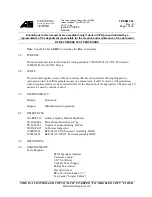
Engine Control System 1A-249
DTC543 - High Engine Speed Error
Circuit Description
The ECM calculates engine speeds using the signals
from CKP and CMP sensors.
DTC543 will be set when the engine speed exceeds
the specified limit due to some reason.
Major Faulty Event
• No pedal response
Conditions for Setting the DTC
The engine speed exceeds 4400 rpm.
Action Taken When the DTC Sets
• Even after the DTC is set, the ECM will not
illuminate the CHECK ENGINE lamp (MIL).
• The ECM stops fuel injection.
Conditions for Clearing MIL/DTC
When the system fails and the DTC is stored to the
ECM, even repairing the faulty portion will not clear the
DTC from the memory. To clear the DTC, conduct the
following steps.
1. Turn off the idle position switch for not less than 1
second but not more than 3 seconds. (Press the
accelerator pedal.)
2. Turn on the idle position switch for not less than 1
second but not more than 3 seconds. (Release the
accelerator pedal.)
3. Turn off the idle position switch for not less than 1
second but not more than 3 seconds. (Press the
accelerator pedal.)
4. Turn on the idle position switch for not less than 1
second but not more than 3 seconds. (Release the
accelerator pedal.)
5. Turn off the idle position switch for not less than 1
second but not more than 3 seconds. (Press the
accelerator pedal.)
6. After the above operations are properly completed,
the CHECK ENGINE lamp (MIL) illuminates for 3
seconds to report the memory is cleared.
7. Turn off the starter switch. Wait for 5 seconds and
turn on the starter switch again.
When Tech 2 has been connected to the vehicle, the
DTC can be cleared through the memory clear
operation with Tech 2.
Diagnostic Aids
Poor connection or damaged harness may cause
intermittents. Check for the following conditions and, if
the fault is detected, repair or replace the faulty portion.
• Poor connection at ECM: Inspect harness
connectors for backed-out pins, improper mating,
broken locks, improperly formed or damaged pins,
and poor pin-to-wire connection.
• Damaged harness: Inspect the wiring harness for
rubbed-through wire insulation or wire broken
inside the insulator. If the harness appears to be
OK, observe the display on Tech 2 while moving
connectors and wiring harnesses related to the
sensor. A change in the display will indicate the
location of the fault.
Step
Action
Value(s)
Yes
No
1
Perform the "On-Board Diagnostic (OBD)
System Check".
Was the OBD System Check performed?
—
Go to Step 2
Refer to OBD
System Check
and go to Step 2
2
Check the driving status (i.e., check whether
improper operation was performed due to
engine overrun). (Hear from the driver about
past driving status.)
Was the operation inappropriate?
—
Go to Step 2
Go to Step 5
3
Inform the driver of engine overrun due to
improper operation and give instructions.
Is the action complete?
—
Go to Step 3
—
4
Check the vehicle for influence by engine
overrun (e.g., engine trouble) and, if fault(s)
are found, repair or replace the faulty
portion(s).
Is the action complete?
—
Go to Step 4
—
















































